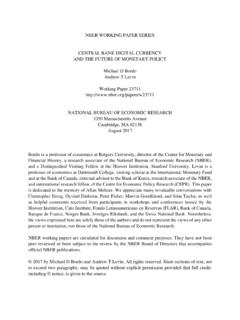Transcription of Measuring Geopolitical Risk - Matteo Iacoviello
1 American Economic Review 2022, 112(4): 1194 1225. Measuring Geopolitical Risk . By Dario Caldara and Matteo Iacoviello *. We present a news-based measure of adverse Geopolitical events and associated risks . The Geopolitical risk (GPR) index spikes around the two world wars, at the beginning of the Korean War, during the Cuban Missile Crisis, and after 9/11. Higher Geopolitical risk foreshadows lower investment and employment and is associated with higher disas- ter probability and larger downside risks . The adverse consequences of the GPR index are driven by both the threat and the realization of adverse Geopolitical events.
2 We complement our aggregate measures with industry- and firm-level indicators of Geopolitical risk. Investment drops more in industries that are exposed to aggregate Geopolitical risk. Higher firm-level Geopolitical risk is associated with lower firm-level investment. (JEL C43, E32, F51, F52, G31, H56, N40). Entrepreneurs, market participants, and central bank officials view geopoliti- cal risks as key determinants of investment decisions and stock market dynamics. The Bank of England includes Geopolitical risk, together with economic and pol- icy uncertainty, among an uncertainty trinity that could have significant adverse economic effects (Carney 2016).
3 In recent years, the European Central Bank, the International Monetary Fund, and the World Bank have routinely highlighted and monitored the risks to the outlook posed by Geopolitical In a 2017 Gallup survey of more than 1,000 investors, 75 percent of respondents expressed worries about the economic impact of the various military and diplomatic conflicts happen- ing around the From the standpoint of many economic models, adverse Geopolitical events and threats can impact macroeconomic variables through several channels, such as loss of human life, destruction of capital stock, higher military spending, or increased * Caldara: Board of Governors of the federal reserve (email: Iacoviello : Board of Governors of the federal reserve (email: Emi Nakamura was the coeditor for this article.))
4 We thank Alessandra Bonfiglioli, Andrea Prestipino, Andrea Raffo, Bo Sun, Chris Erceg, Colin Flint, Nick Bloom, Nils Gornemann, Ricardo Correa, Robert Engle, Steve Davis, as well as seminar and conference audiences. We are grateful for the support from the GRUV (Global Risk, Uncertainty, and Volatility) network at the federal reserve Board and for the help from the staff of the federal reserve Board Research Library. We are grateful to the editor and four referees for their helpful and constructive comments. Andrew Kane, Bethel Cole-Smith, Charlotte Singer, Erin Markiewitz, Fatima Choudhary, Joshua Herman, Lucas Husted, Maddie Penn, Patrick Molligo, Sarah Conlisk, and Theresa Dhin provided outstanding research assistance.
5 All errors and omissions are our own responsibility. The views expressed in this paper are solely the responsibility of the authors and should not be interpreted as reflecting the views of the Board of Governors of the federal reserve System or of anyone else associated with the federal reserve System. Updated data on Geopolitical risk can be found at . Go to to visit the article page for additional materials and author disclosure statements. 1. These institutions keep track of Geopolitical risks using our index presented here. 2. See 1194. VOL. 112 NO. 4 CALDARA AND Iacoviello : Measuring Geopolitical RISK 1195.
6 Precautionary behavior. However, the importance of Geopolitical factors in shaping macroeconomic outcomes has not been the subject of systematic empirical analysis. The main limitation has been the lack of an indicator that is consistent over time, and that measures r eal-time Geopolitical tensions as perceived by the press, the pub- lic, global investors, and policymakers. This is the perspective we adopt here. We construct newspaper-based indices of Geopolitical risk (GPR), daily and monthly, global and country-specific, and examine their evolution since 1900. Using aggre- gate macroeconomic data, we then show that higher GPR increases the probabil- ity of an economic disaster and predicts lower investment and employment.
7 Using firm-level data, we document that the adverse implications of Geopolitical risk are stronger for firms in more exposed industries, and that high fi rm-level GPR is asso- ciated with lower firm-level investment. The construction of our index consists of definition, measurement, and validation. Section I presents definition and measurement. We define Geopolitical risk as the threat, realization, and escalation of adverse events associated with wars, terrorism, and any tensions among states and political actors that affect the peaceful course of international In the measurement step, we draw on Saiz and Simonsohn (2013) and Baker, Bloom, and Davis (2016), and construct the GPR index with an algorithm that computes the share of articles mentioning adverse Geopolitical events in leading newspapers published in the United States, the United Kingdom, and Canada.
8 These newspapers cover Geopolitical events of global interest, often implying an involvement of the United States. That said, while the GPR index can be viewed either as a measure that is relevant for major companies, investors, and policymakers, or as a measure that is mostly relevant from a North American and British perspective, our validation analysis shows that our index can be further sliced into separate country-specific components, likely reflecting the different geographic imprint of major Geopolitical events. We plot the recent index, dating back to 1985, in Figure 1. The three largest spikes are recorded during the Gulf War, after 9/11, and during the 2003 invasion of Iraq.
9 More recently, the index spikes after the Paris terrorist attacks and during the 2017 2018 North Korea crisis. We also construct the daily GPR index (Figure 2) as well as the historical GPR index, dating back to 1900, which spikes at the beginning of the two world wars, as well as around D -Day, the Korean War, and the Cuban Missile Crisis (Figure 3). Elevated readings of the index reflect the realization or escalation of current adverse events, as well as expectations and threats about future adverse Geopolitical events. To quantify these two components, we construct the Geopolitical acts index and the Geopolitical threats index, shown in Figure 4.
10 In Section II we present a variety of checks that verify the plausibility of the GPR index and compare the index with related economic and Geopolitical indi- cators. In addition to performing a formal audit of a sample of 7,000 newspaper articles, we verify that our automated index is highly correlated with a narrative counterpart constructed by manually scoring the 44,000 front pages of the New York Times published from 1900 through 2019. Moreover, we show that spikes in our index and its components highlight w ell-known historical episodes associated with 3. The term risk is a bit of a misnomer, since it includes both the threat and the realization of adverse events.



